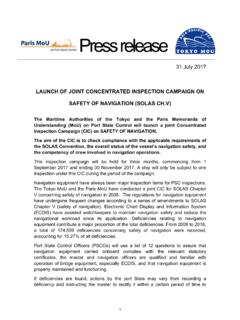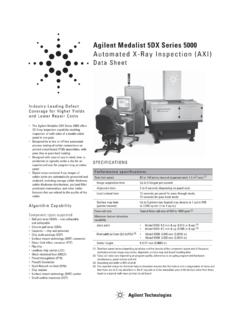Transcription of 360R-06 Design of Slabs-on-Ground - NICFI
1 ACI 360R-06 supersedes 360R-92 (Reapproved 1997) and became effectiveAugust 9, 2006, American Concrete rights reserved including rights of reproduction and use in any form or by anymeans, including the making of copies by any photo process, or by electronic ormechanical device, printed, written, or oral, or recording for sound or visual reproductionor for use in any knowledge or retrieval system or device, unless permission in writingis obtained from the copyright proprietors. 360R-1 ACI Committee Reports, Guides, Standard Practices, andCommentaries are intended for guidance in planning,designing, executing, and inspecting construction. Thisdocument is intended for the use of individuals who arecompetent to evaluate the significance and limitations of itscontent and recommendations and who will acceptresponsibility for the application of the material it American Concrete Institute disclaims any and allresponsibility for the stated principles.
2 The Institute shall notbe liable for any loss or damage arising to this document shall not be made in contractdocuments. If items found in this document are desired by theArchitect/Engineer to be a part of the contract documents, theyshall be restated in mandatory language for incorporation bythe of Slabs-on-GroundReported by ACI Committee 360 ACI 360R-06 This document presents information on the Design of Slabs-on-Ground ,primarily industrial floors. The report addresses the planning, Design , anddetailing of slabs. Background information on Design theories is followedby discussion of the types of slabs, soil-support systems, loadings, andjointing. Design methods are given for unreinforced concrete, reinforcedconcrete, shrinkage-compensating concrete, post-tensioned concrete, fiber-reinforced concrete Slabs-on-Ground , and Slabs-on-Ground in refrigeratedbuildings, followed by information on shrinkage and curling and disadvantages of each of these slab designs are provided,including the ability of some slab designs to minimize cracking and curlingmore than others.
3 Even with the best slab designs and proper construction,however, it is unrealistic to expect crack-free and curl-free floors. Conse-quently, every owner should be advised by both the designer and contrac-tor that it is normal to expect some amount of cracking and curling onevery project, and that such occurrence does not necessarily reflectadversely on either the adequacy of the floor s Design or the quality of itsconstruction. Design examples appear in an : concrete; curling; Design ; floors-on- ground ; grade floors;industrial floors; joints; load types; post-tensioned concrete; reinforcement(steel, fibers); shrinkage; shrinkage-compensating; slabs; Slabs-on-Ground ;soil mechanics; shrinkage; 1 Introduction, p. Purpose and Work of Committee 360 and other relevant Work of non-ACI Design theories for Overview of subsequent Further researchChapter 2 slab types, p.
4 slab General comparison of slab Design and construction ConclusionChapter 3 Support systems for Slabs-on-Ground , p. Geotechnical engineering Subgrade Modulus of subgrade Design of slab -support Site Inspection and site testing of slab Special slab -on- ground support problemsJ. Howard AllredBarry E. ForemanJoseph F. Neuber, Fattah ShaikhCarl BimelTerry J. FricksRussell E. NeudeckRichard E. SmithJoseph A. BohinskyPatrick J. HarrisonScott L. NiemitaloScott M. TarrWilliam J. BrickeyJerry A. Holland*Nigel K. ParkesR. Gregory TaylorJoseph P. BuongiornoPaul B. LafontaineRoy H. ReitermanEldon G. TippingAllen FaceSteven N. MetzgerJohn W. RohrerWayne W. WalkerC. Rick FelderJohn P. Munday*Chair of ACI 360 who served during a portion of the time required to create this committee would also like to acknowledge Miroslav Vejvoda for his contributions as Chair of the Prestressing Subcommittee and Roy Leonard (deceased) for hiswork on soil support W.
5 McKinneyChairRobert B. AndersonVice ChairPhilip BrandtSecretary360R-2 ACI COMMITTEE REPORTC hapter 4 Loads, p. Vehicular concentrated Distributed Line and strip Unusual Construction Environmental Factors of safetyChapter 5 Joints, p. Load-transfer Sawcut contraction Joint Joint filling and sealingChapter 6 Design of unreinforced concrete slabs, p. Thickness Design Shear transfer at Maximum joint spacingChapter 7 Design of slabs reinforced for crack-width control, p. Thickness Design Reinforcement for crack-width control Reinforcement for moment Reinforcement locationChapter 8 Design of shrinkage-compensating concrete slabs, p. Thickness Other considerationsChapter 9 Design of post-tensioned Slabs-on-Ground , p. Applicable Design Slabs post-tensioned for crack Industrial slabs with post-tensioned reinforcementfor structural support Residential slabs with post-tensioned reinforcementfor structural Design for slabs on expansive Design for slabs on compressible soilChapter 10 Fiber-reinforced concrete Slabs-on-Ground , p.
6 Polymeric fiber Steel fiber reinforcementChapter 11 Structural Slabs-on-Ground supporting building code loads, p. Design considerationsChapter 12 Design of slabs for refrigerated facilities, p. Design and specification Temperature drawdownChapter 13 Reducing effects of slab shrinkage and curling, p. Drying and thermal Curling and Factors that affect shrinkage and Compressive strength and Compressive strength and abrasion Removing restraints to Base and vapor Distributed reinforcement to reduce curling andnumber of Thickened edges to reduce Relation between curing and Warping stresses in relation to joint Warping stresses and Effect of eliminating sawcut contraction jointswith post-tensioning or Summary and conclusionsChapter 14 References, p. Referenced standards and Cited referencesAPPENDIXA ppendix 1 Design examples using PCA method, p.
7 PCA thickness Design for single-axle PCA thickness Design for slab with post Other PCA Design informationAppendix 2 slab thickness Design by WRI method, p. WRI thickness selection for single-axle wheel WRI thickness selection for aisle moment due touniform loadingAppendix 3 Design examples using COE charts, p. Vehicle wheel Heavy forklift loadingAppendix 4 slab Design using post-tensioning, p. Design example: Residential slabs on expansive soilDESIGN OF Design example: Using post-tensioning to Design example: Equivalent tensile stress designAppendix 5 Examples using shrinkage-compensating concrete, p. Introduction Example with amount of steel and slab jointspacing predeterminedAppendix 6 Design examples for steel FRC Slabs-on-Ground using yield line method,p. Assumptions/ Design criteriaConversion factors, p. 360R-74 CHAPTER 1 Purpose and scopeThis guide presents state-of-the-art information on thedesign of Slabs-on-Ground .
8 Design is defined as the decision-making process of planning, sizing, detailing, and developingspecifications preceding construction of on other aspects, such as materials, constructionmethods, placement of concrete, and finishing techniques, isincluded only where it is needed in making Design the context of this guide, slab -on- ground is defined as:a slab , supported by ground , whose main purpose is tosupport the applied loads by bearing on the ground . The slabmay be of uniform or variable thickness, and it may includestiffening elements such as ribs or beams. The slab may beunreinforced, reinforced, or post-tensioned concrete. Thereinforcement steel may be provided to limit the crackwidths resulting from shrinkage and temperature restraintand the applied loads. Post-tensioning steel may be providedto minimize cracking due to shrinkage and temperaturerestraint and to resist the applied guide covers the Design of Slabs-on-Ground for loadsfrom material stored directly on the slab , storage rack loads,and static and dynamic loads associated with equipment andvehicles.
9 Other loads, such as loads on the roof transferredthrough dual-purpose rack systems, are also addition to Design , this guide discusses soil-supportsystems; shrinkage and temperature effects; cracking, curlingor warping; and other concerns affecting slab Design . Althoughthe same general principles are applicable, this guide does notspecifically address the Design of roadway pavements, airportpavements, parking lots, and mat Work of ACI Committee 360 and other relevant ACI Committee 360 develops and reports on criteriafor Design of Slabs-on-Ground , with the exception of highwayand airport pavements, parking lots, and mat ACI Committee 302 develops recommendations forconstruction of slab -on- ground and suspended- slab floorsfor industrial, commercial, and institutional buildings. provides guidelines and recommendations onmaterials and slab ACI Committee 223 develops recommendations onthe use of shrinkage-compensating ACI Committee 325 addresses the structural Design ,construction, maintenance, and rehabilitation of ACI Committee 332 develops information on theuse of concrete for one- and two-family dwellings andmultiple single-family dwellings not more than threestories in height as well as accessory structures (residential).
10 Where a residential slab -on- ground is placed, only loadingsfrom pedestrian and passenger vehicles are expected. Theslab should be continuously supported throughout andplaced on suitable soil or controlled fill where little volumechange is expected. Where these conditions are not met, aresidential slab -on- ground should be designed specificallyfor the ACI Committee 336 addresses Design and relatedconsiderations of foundations that support and transmitsubstantial loads from one or more structural members. Thedesign procedures for mat foundations are given in Mat foundations are typically more rigid and moreheavily reinforced than common ACI Committee 330 monitors developments andprepares recommendations on Design , construction, andmaintenance of concrete parking lots. Parking lot pavementshave unique considerations that are covered in ACI 330R,which includes Design and construction- and discussions onmaterial specifications, durability, maintenance, and ACI Committee 544 provides measurement ofproperties of fiber-reinforced concrete (FRC); a guide forspecifying proportioning, mixing, placing, and finishingsteel FRC; and Design considerations for steel Work of non-ACI organizationsNumerous contributions of Slabs-on-Ground come fromorganizations and individuals outside the American ConcreteInstitute.








